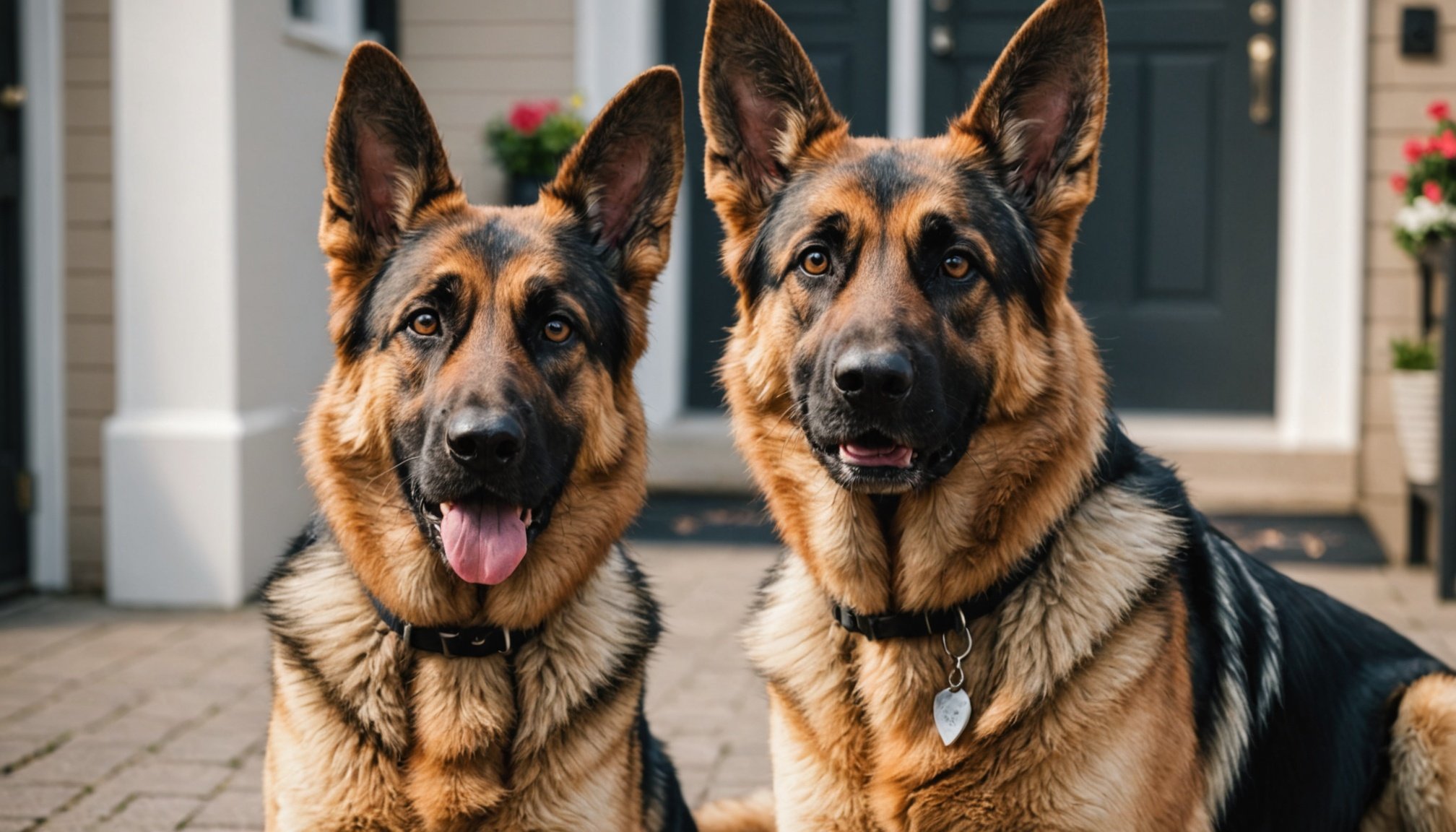Understanding the Protective Nature of German Shepherds
German Shepherds are renowned for their strong protective instincts. At the core of their nature, they possess instincts that make them exceptional guardians. As a breed, German Shepherds often display specific behaviors when safeguarding their territory. These behaviors can include territorial barking, vigilant patrolling, and the tendency to physically place themselves between perceived threats and family members—a testament to their deep-seated protective behaviors.
Understanding these instincts is crucial for successful introductions between German Shepherds and new people or environments. Being aware of what triggers their protective responses can help mitigate potential conflicts or stress. Recognising these natural tendencies, owners can better prepare for situations involving the canine protection roles that German Shepherds instinctively take on.
In parallel : How can I choose the right toys for my dog based on their age, size, and play style?
When providing a German Shepherd with the appropriate environment and security, owners can channel these instincts positively. This ensures that the dog’s natural protective behavior is expressed appropriately, without causing unnecessary anxiety or territorial aggression. Essentially, a comprehensive understanding of these instincts is foundational in nurturing their role as trusted protectors and loyal companions, providing a harmonious living dynamic for both the dog and its household.
Preparing Your Dog for Guest Introductions
Preparing your dog for guest introductions involves dog training tips and effective strategies, ensuring a smooth and friendly encounter. Pre-introduction training is vital, focusing on commands and basic obedience. Teaching commands such as “sit,” “stay,” and “leave it” can establish control and behaviour management during introductions.
Also read : How can I identify the right toys for my dog’s chewing habits to prevent destruction at home?
Socialization is key to familiarity. Engage your German Shepherd in activities that expose them to diverse people, allowing them to identify different body languages and temperaments. Frequent visits to parks or busy areas can increase their comfort with new faces and reduce unfamiliarity-induced anxiety.
Desensitization techniques play a crucial role in mitigating stress during guest arrivals. Begin by associating guest cues, like doorbells, with positive experiences using treats or praise. Gradually expose them to these cues in controlled settings, reinforcing calm behaviour every step of the way.
By emphasizing these methods, owners can boost their German Shepherd’s confidence and adaptability in social situations. This approach not only assures safer interactions but also strengthens the bond between you and your pet. Incorporating structured training methods encourages positive development and equips your canine companion to handle varied social scenarios skillfully.
Creating a Welcoming Environment for Guests
When preparing for guest visits, it is vital to consider both your dog and visitors’ experiences. Establishing a designated space for your German Shepherd ensures they have a safe retreat during guest interactions. This area can be equipped with their favourite toys, a comfortable bed, and other comforting items. By creating such a space, you reduce potential territorial anxiety while providing a controlled environment for initial introductions.
Effective home environment management guides the overall ambiance of your household during visits. Encourage guests to ignore your dog immediately upon arrival, allowing your pet to relax and gauge the situation independently. This practice minimizes unnecessary excitement or stress. Introduce visitors gradually, only when your dog displays a calm demeanor, thereby enhancing both comfort and interaction safety.
Taking safety measures is paramount for ensuring harmonious interactions. Inform guests beforehand about any important guidelines, like maintaining a calm composure when greeting your German Shepherd. This preemptive approach leads to more comfortable interactions for everyone involved. By respecting your dog’s space and behavioural signals, you create a welcoming environment conducive to enjoyable and safe social encounters, helping both guests and your dog feel at ease.
Steps for Gradual Introductions
Creating a harmonious environment demands a thoughtful introduction process for your German Shepherd and your guests. Initial approaches should be calm and structured, aiming to introduce your dog to new faces without overwhelming them. Begin in a neutral space where both the dog and guest feel comfortable.
It’s crucial to use gradual exposure techniques. Allow your German Shepherd to approach the guest at its own pace, rewarding calm behaviors with treats or praise. Gradually increase the proximity and duration of interactions over multiple sessions. This helps the dog build positive associations with the guest.
Understanding and managing your dog’s signals is vital. Watch for signs of stress or discomfort like stiff body language or excessive panting. If these occur, give your dog a break to decompress. Encourage guests to respect the dog’s boundaries, especially during initial meetings.
Employ effective interaction techniques by involving guests in simple activities like play or training. This not only helps the dog associate guests with positive experiences but also enhances social skills. Over time, your German Shepherd will become more comfortable and confident with new people, ensuring safe and enjoyable interactions.
Training Your Dog for Appropriate Guest Interactions
Establishing effective training methods is essential for facilitating appropriate guest interactions for your German Shepherd. Regular training fosters good manners, ensuring a calm reception for visitors. A cornerstone of this process involves teaching behavioral reinforcement techniques to encourage desired actions and discourage undesirable ones.
Positive reinforcement plays a crucial role in embedding good behavior. Reward your dog with treats or praise whenever they greet a guest calmly. This association strengthens their understanding of acceptable conduct during such encounters. It’s vital to remain consistent with this approach, as it helps your dog learn which behaviors are beneficial.
Creating specific training scenarios that simulate real-life guest introductions can greatly aid in your dog’s behavioral development. Practice welcoming a “guest” who plays along with the training exercises in controlled settings. This experience assists your German Shepherd in becoming accustomed to the interaction dynamics.
Utilising these guest interaction training strategies allows your German Shepherd to become more relaxed and sociable. It ultimately enhances their confidence in navigating various social situations. Over time, this structured approach ensures that welcoming guests becomes a more pleasant experience, both for your dog and any visitors.
Real-Life Examples and Success Stories
Sharing anecdotes and success stories about German Shepherds can significantly boost confidence for owners introducing their dogs to new guests. One memorable example is of a family who employed gradual exposure techniques to help their German Shepherd overcome territorial instincts.
Case studies like this showcase the benefits of patience, repetition, and positive reinforcement. Initially, the dog displayed typical protective behavior, such as barking and positioning itself between family and strangers. Through consistent training and controlled exposure, the Shepherd began to associate guests with positive experiences.
Owners explored diverse introduction experiences by inviting friends and family to simulate guest arrivals. They introduced activities like obedience drills and play, encouraging their dog to remain calm and sociable.
These stories often highlight common challenges, such as managing initial anxiety and territorial urges. However, by understanding these behaviors and applying proper techniques, owners can lead their dogs toward better social adaptability. One might learn from others who have successfully transformed their Shepherd’s behavior, illustrating practical approaches and celebrating milestones achieved in their own training journey.
Overcoming obstacles through real-life experiences provides insightful learning and motivation, fostering a harmonious relationship between dogs, their owners, and guests.










